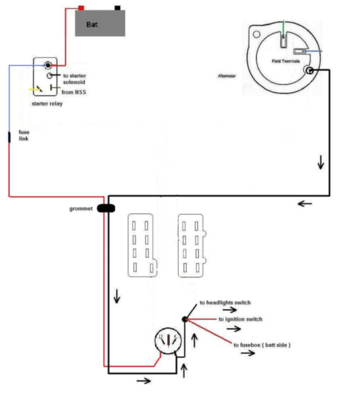Mopar4Speed
Well-Known Member
Hi all, first post here. Have been reading off this forum for a bit now and wanted to discuss some changes between the two mods.
I like the idea of both mods but am leaning towards nacho's idea because i'd like to keep the ammeter in play. It saved me from melting my harness already (went full field) which gave me enough time to stop and shut the engine off and if it wasn't for the ammeter doing its job it wouldn't have ended well. The car in question is a 1966 coronet, low options (no a/c) and am using a 100amp tuff stuff alt.
So according to Nacho's upgrade, he does a parallel wiring routing for the charging and bat feed system. Now he said that he recommends 8ga charging and 10ga bat feed wires and leave the oem wiring in place. It seems really great but there is still power running through the bulkhead which may have fixed the wires/bulkhead from burning up completely but i thought to maybe it would be even better to disconnect the small gauge wires completely from the bulkhead and instead run a 6ga charge wire (rated to 150amps as per manufacturer) and a 8ga batt feed. I would the feed from the alt via 6ga straight to the amm but also hook up the original wiring inside the dash and de-pin the oem charging cable from the bulkhead. This would allow me to leave the dash side harness unmodified so it can feed the car as normal. Same deal for the for the batt feed remove/de-pin the oem wire and then replace with 14ga fuse link and 8ga wire. I put in a pic of nacho's diagram that i modified slightly to help explain.
If anyone could chime in with some insight or thoughts i'd appreciate it, Thanks

I like the idea of both mods but am leaning towards nacho's idea because i'd like to keep the ammeter in play. It saved me from melting my harness already (went full field) which gave me enough time to stop and shut the engine off and if it wasn't for the ammeter doing its job it wouldn't have ended well. The car in question is a 1966 coronet, low options (no a/c) and am using a 100amp tuff stuff alt.
So according to Nacho's upgrade, he does a parallel wiring routing for the charging and bat feed system. Now he said that he recommends 8ga charging and 10ga bat feed wires and leave the oem wiring in place. It seems really great but there is still power running through the bulkhead which may have fixed the wires/bulkhead from burning up completely but i thought to maybe it would be even better to disconnect the small gauge wires completely from the bulkhead and instead run a 6ga charge wire (rated to 150amps as per manufacturer) and a 8ga batt feed. I would the feed from the alt via 6ga straight to the amm but also hook up the original wiring inside the dash and de-pin the oem charging cable from the bulkhead. This would allow me to leave the dash side harness unmodified so it can feed the car as normal. Same deal for the for the batt feed remove/de-pin the oem wire and then replace with 14ga fuse link and 8ga wire. I put in a pic of nacho's diagram that i modified slightly to help explain.
If anyone could chime in with some insight or thoughts i'd appreciate it, Thanks

















